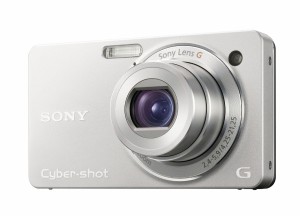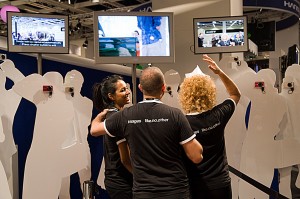Exmor R hits the High Street – new Cyber-shots
SONY puts two 10.2 megapixel consumer digicams on the market in September 2009 using the back-illuminated Exmor R sensor. This CMOS sensor architecture takes the ‘sandwich’ which forms the light-sensitive pixel wells, and reverses it so that the side previously used for connections now faces the image-forming light. This change allows more light to be captured, resulting in improved high ISO performance. So far, the Exmor R technology has only been used in video cameras and this is the first appearance of it in still cameras. The cameras can shoot at 10 frames per second.

The TX-1 uses a folded-path Zeiss 4X zoom lens, and is designed to be pocketable. Like many current Sony Cyber-shot models, in comes in an assortment of colours fortunately including the regulation metallic neutrals as well as electric blue and shocking pink.

It is slim enough to fit in the pocket which will be empty after you’ve bought it! The WX-1 uses a more ambitious lens, which extends from the body in traditional style. This is a 5X zoom with a wide-angle equivalent of 24mm (24-120mm, just like the Cybershot DSC R1) and it is a Sony G. Does that mean it was really made by the Konica Minolta optical division, and the TX-1 lens made by the Sony-Zeiss factory?

The real 4.25-21.25mm range of this f/2.4-5.9 zoom gives you a clue as to how tiny the Exmor R sensor actually is. The physical area of the CMOS is about 1/3rd of the area of the 8 megapixel sensor of the classic Konica Minolta Dimage A2 or A200 models. Although the high ISO may be improved, Sony is starting out with an extremely fine pixel pitch to get 10.2 megapixels into a sensor this size.
The two cameras also share some features we expect to see in all future higher-end Sony Cybershots – Sweep Panorama mode (first seen in the HX-1) which stitches a panorama from a smooth pan across any scene; 720p 30fps HD video; the new Twilight mode which shoots six frames at a very high burst speed and then blends them to remove noise; an Anti-Blur mode which uses a similar process to analyse burst capture and synthesize the sharpest result.
Optical SteadyShot, not sensor-based, is included in both models. Smile and Face Recognition are used, and this is critical to one accessory – the robotic camera base called IPT-DS1 Party-Shot, which we first saw demonstrated at photokina 2008. This little dock (a bit like the original charging and file transfer dock for the Konica Minolta Dimage X1 in appearance) holds the camera and has a rotating, tilting action which responds to face detection through the live view finder. It will turn and scan the room or location until it recognises a person, or a group, which it then composes automatically. Finally, when it detects a smile or more than one smile in the subjects, it fires the camera.

Sony’s own staff were having such a good time messing around with this device and with the displays of Smile Capture cameras linked to TV monitos, posing and running around the photokina stand, that they hardly noticed any of the visitors waiting to find someone to talk to:

But we were asked not to photograph the prototype Party-Shot, just to look at it and give an opinion on whether or not Sony should make this product. Seems like they got a positive vote!
Now why didn’t they ask for an opinion on whether we wanted a 400mm f/4.5, 300mm f/4, 85mm f/1.8, 35mm f/2 and a few wee changes to firmware?
The following is extracted from Sony’s rather gushing press release, superfluous superlatives generally removed.
• 10.2 effective megapixels with Exmor R™ CMOS Sensor and BIONZ imaging processor for responsive shooting and superb low-noise images, even in low light
• High Definition movie recording capabilities
• Sweep Panorama mode automatically captures extra-wide landscapes
• Turn Cyber-shot™ into your own Personal Photographer with optional Party-shot™
• (TX1 only) Carl Zeiss 4x optical zoom lens and extra large, wide 3″ Clear Photo LCD Plus touchscreen with easy-to-use new touch interface
• (WX1 only) High quality f/2.4 Sony ‘G lens’ with 5x optical zoom and 24mm wide angle
A BIONZ processor features in both models. The mechanical shutter of the TX1 and WX1 can grab a continuous burst of full-resolution images at 10 frames per second – quicker than many professional DSLR cameras. This combination of the Exmor R sensor and BIONZ processor also powers Sweep Panorama mode. Just press the shutter button once and move the TX1 or WX1 from side to side horizontally or vertically. Sweep Panorama automatically combines a high-speed burst of images, capturing super-size landscapes with a field of view up to 256 degrees* – far wider than any camera’s wide angle lens.
Hand-held Twilight mode superimposes a high-speed burst of six frames to produce an optimised image with dramatically reduced noise in low light. Anti Motion Blur mode captures fast-moving subjects in low light also with reduced picture noise.
Both cameras shoot 720p HD movie clips and audio at 30 frames per second.
Optical SteadyShot image stabilisation keeps images crisp and clear when you’re shooting handheld. Face Detection and Smile Shutter let anyone take happy, better-looking portraits automatically. Party-shot™ acts as your ‘Personal Photographer’, automatically taking pictures without intervention. The IPT-DS1 pans and tilts the camera while adjusting zoom settings. Face Detection and Smile Shutter recognise and track faces for naturally composed pictures of everyone in the room.
The latest Memory Stick™ PRO Duo 32GB is a perfect partner for your Cyber-Shot™ on long trips. There’s space for thousands of high-resolution 10.1 megapixel images or 7 hr 25 mins of Full HD video.
Cyber-shot™ TX1 and WX1 compact digital cameras and IPT-DS1 Party-shot™ are available from September 2009.
All the features of the Exmor R CMOS sensor will be utilised to the full when the TX1 and WX1 products will be used at Sony’s Twilight Football events in September. For more information on Twilight Football, please visit: www.sony.co.uk/twilightfootball
– DK
